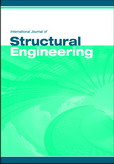
International Journal of Structural Engineering
Scope & Guideline
Fostering Excellence in Structural Engineering Research
Introduction
Aims and Scopes
- Structural Behavior Analysis:
The journal publishes studies that analyze the behavior of various structural elements, including beams, columns, and frames under different loading conditions and environmental factors. - Material Innovations:
Research on new and improved materials for construction, such as geopolymer concrete, high-strength polymers, and composite materials, is a significant focus area. - Seismic and Dynamic Analysis:
There is a strong emphasis on seismic performance assessment and dynamic analysis of structures, including the use of advanced methodologies for earthquake-resistant design. - Soil-Structure Interaction:
The journal addresses the interactions between soil and structures, focusing on their impact on structural integrity and performance, particularly in geotechnical engineering contexts. - Experimental and Computational Techniques:
A blend of experimental investigations and computational simulations is often presented, showcasing innovative methodologies for structural assessment and design. - Sustainability and Waste Management:
The journal also explores sustainable construction practices, including the use of waste materials in concrete and strategies for improving the environmental impact of construction.
Trending and Emerging
- Advanced Computational Methods:
There is a growing trend towards the use of sophisticated computational techniques, such as machine learning and finite element analysis, for structural modeling and damage detection. - Resilience and Sustainability:
Research focusing on enhancing the resilience of structures to environmental impacts and disasters, along with sustainable construction practices, is increasingly prominent. - Smart Materials and Systems:
The integration of smart materials and systems, such as shape memory alloys and self-sensing materials, is an emerging theme, showcasing the potential for innovative solutions in structural engineering. - Health Monitoring and Assessment:
The use of advanced health monitoring techniques, including acoustic emission and machine learning for structural integrity assessment, is gaining attention. - Behavior of Composite Structures:
Studies on the behavior and design of composite structures, including novel shear connectors and hybrid materials, are increasingly featured in recent publications.
Declining or Waning
- Traditional Reinforcement Techniques:
Research on conventional reinforcement methods, such as steel reinforcement in concrete, appears to be decreasing as new materials and techniques gain popularity. - Static Load Analysis:
Studies focusing solely on static load analysis without considering dynamic or environmental factors are becoming less common, reflecting a shift towards more comprehensive analysis methods. - Basic Structural Design Principles:
Papers discussing fundamental structural design principles without incorporating modern technologies or advanced methodologies are less frequently published, suggesting a move towards more innovative approaches.
Similar Journals

STRUCTURAL ENGINEERING AND MECHANICS
Defining the Future of Engineering ResearchSTRUCTURAL ENGINEERING AND MECHANICS, a leading journal published by TECHNO-PRESS, stands at the forefront of research in the disciplines of civil, structural, and mechanical engineering. With an ISSN of 1225-4568 and an E-ISSN of 1598-6217, this South Korea-based journal has been a significant contributor to the academic community since its inception in 1994, and it continues to disseminate vital research through 2024 and beyond. Achieving a Q3 ranking in key categories such as Building and Construction, Civil and Structural Engineering, Mechanical Engineering, and Mechanics of Materials, the journal is recognized for its high standard of academic rigour and relevance in contemporary engineering challenges. Although not Open Access, it offers robust access options for institutions and professionals seeking to advance their understanding of structural systems and mechanics. Researchers, students, and practitioners in these fields will find invaluable insights and innovative studies that push the boundaries of knowledge, making this journal an essential resource for anyone invested in engineering advancements.
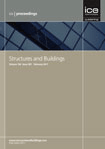
PROCEEDINGS OF THE INSTITUTION OF CIVIL ENGINEERS-STRUCTURES AND BUILDINGS
Advancing the Future of Civil EngineeringPROCEEDINGS OF THE INSTITUTION OF CIVIL ENGINEERS-STRUCTURES AND BUILDINGS, published by Emerald Group Publishing Ltd, is a leading journal in the fields of Building and Construction and Civil and Structural Engineering. Since its inception in 1992, this journal has served as a vital platform for disseminating high-quality research and innovative practices within the industry, contributing to the advancement of engineering knowledge and its applications. With an impact factor reflective of its significant presence in the field, this publication ranks in the Q3 category, reinforcing its role as an essential resource for researchers and professionals alike, positioning it among the top journals in its category. As of 2023, it holds notable Scopus rankings, emphasizing its credibility and influence within both Building and Construction (Rank #88/223) and Civil and Structural Engineering (Rank #171/379). Researchers aiming to enhance their understanding of cutting-edge developments in civil engineering will find this journal indispensable in accessing a wealth of knowledge, methodologies, and case studies that shape the infrastructures of tomorrow.
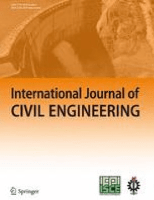
International Journal of Civil Engineering
Advancing Sustainable Solutions in Civil EngineeringThe International Journal of Civil Engineering, published by Springer International Publishing AG, is a premier platform dedicated to advancing the field of civil engineering. With a notable impact factor and a strong reputation reflected in its Q2 quartile rankings in both Civil and Structural Engineering as well as Geotechnical Engineering and Engineering Geology, this journal facilitates the dissemination of high-quality research from 2009 through 2024. Researchers and professionals can access cutting-edge studies and innovative practices that address contemporary challenges in civil engineering, such as sustainable infrastructure development, environmental impacts, and advanced material technologies. Situated in Switzerland, the International Journal of Civil Engineering emphasizes the critical interplay between theory and application, making it an essential resource for students, academics, and industry leaders seeking to stay at the forefront of their disciplines.
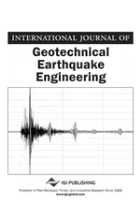
International Journal of Geotechnical Earthquake Engineering
Advancing seismic resilience through innovative geotechnical research.International Journal of Geotechnical Earthquake Engineering, published by IGI Global, serves as a pivotal platform for researchers and practitioners in the field of geotechnical engineering and engineering geology. Established in 2010, this journal has steadily promoted the dissemination of innovative research and advancements in understanding the impact of seismic activities on soil behavior and structural integrity. Operating out of the United States, it caters to a global audience and offers a range of articles that delve deep into the dynamics of earthquake engineering. With a 2023 Scopus ranking placing it in the 39th percentile among its peers and a Q4 designation in the relevant quartile, the journal actively seeks to elevate the discussion around geotechnical challenges associated with seismic events. While currently not classified as an Open Access journal, it remains committed to providing valuable insights that aid in the prevention and mitigation of geotechnical failures during earthquakes. Researchers, professionals, and students alike will find this journal an essential resource for the latest developments and practical applications in this ever-evolving field.
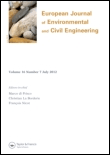
European Journal of Environmental and Civil Engineering
Pioneering Research at the Intersection of Environment and InfrastructureThe European Journal of Environmental and Civil Engineering, published by Taylor & Francis Ltd, is a prestigious peer-reviewed journal that serves as a vital platform for advancing knowledge in the fields of Civil and Structural Engineering as well as Environmental Engineering. With an impressive impact factor and categorized in the Q2 quartile for both engineering fields, this journal occupies a significant position in the scholarly community. Its focused scope encompasses innovative research, case studies, and practical applications that address contemporary environmental and infrastructural challenges. Researchers, professionals, and students alike benefit from the journal's commitment to high-quality discourse, as evidenced by its Scopus rankings, which place it in the top 30% in Civil and Structural Engineering and the top 40% in Environmental Engineering. Through the publication of cutting-edge studies and a commitment to fostering interdisciplinary dialogue, the European Journal of Environmental and Civil Engineering remains an essential resource for those dedicated to improving our built environment and safeguarding our natural resources.
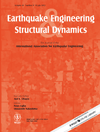
EARTHQUAKE ENGINEERING & STRUCTURAL DYNAMICS
Exploring the frontiers of earthquake engineering.EARTHQUAKE ENGINEERING & STRUCTURAL DYNAMICS, published by Wiley, is a leading journal recognized for its significant contributions to the domains of civil and structural engineering, as well as geotechnical engineering and engineering geology. With an impressive Q1 ranking in multiple categories, including Civil and Structural Engineering, and an esteemed Scopus ranking placing it in the 82nd percentile, the journal serves as a premier platform for disseminating pioneering research and innovative methodologies related to earthquake engineering and dynamic structural analysis. Established in 1972, this journal boasts a comprehensive coverage of topics from theoretical developments to practical applications, making it an essential resource for researchers, industry professionals, and students eager to expand their understanding of seismic safety and structural resilience. Though it does not offer open access, the journal continues to be a cornerstone for scholarly communication within the earthquake engineering community, advancing knowledge that shapes better engineering practices worldwide.

SHOCK AND VIBRATION
Exploring the dynamics of engineering and physics.SHOCK AND VIBRATION, published by HINDAWI LTD, is an esteemed open-access journal that has been disseminating vital research in the fields of Civil and Structural Engineering, Condensed Matter Physics, Geotechnical Engineering and Engineering Geology, Mechanical Engineering, and Mechanics of Materials since its inception in 1993. Based in Egypt, this journal has earned its place within the Q3 quartile rankings across multiple engineering and science categories, showcasing its growing influence and commitment to advancing knowledge in these domains. Accessible to a global audience, it allows researchers, professionals, and students to share findings and foster innovation without paywalls. The journal proudly contributes to a deeper understanding of shock and vibration phenomena, addressing both theoretical and practical applications essential for various engineering disciplines. As a vital resource for academics and industry professionals alike, SHOCK AND VIBRATION serves as a cornerstone for the ongoing exploration and development of cutting-edge solutions in the engineering landscape.

Slovak Journal of Civil Engineering
Advancing civil engineering through open access innovation.Welcome to the Slovak Journal of Civil Engineering, a premier open-access publication dedicated to advancing the field of civil engineering. Published by SCIENDO, this journal has been providing a platform for the dissemination of groundbreaking research since 2010, ensuring that all articles are freely accessible to a global audience. With a commitment to promoting innovation and excellence within civil engineering, the journal covers a wide range of topics, including structural engineering, transportation systems, geotechnics, and environmental engineering. The Slovak Journal of Civil Engineering is designed to engage a diverse community of researchers, professionals, and students, fostering collaboration and knowledge-sharing to address contemporary challenges in the field. With its open-access model, the journal not only enhances visibility for authors but also ensures that the latest findings and methodologies reach practitioners and academics alike, making it an essential resource for anyone interested in civil engineering advancements. Stay connected with the evolving landscape of civil engineering through this influential publication.

Electronic Journal of Structural Engineering
Pioneering Research for Sustainable Infrastructure DevelopmentThe Electronic Journal of Structural Engineering (ISSN: 1443-9255), published by EJSE INT LTD, serves as a vital platform for disseminating innovative research and developments in the field of structural engineering. Since its inception in 2001, the journal has evolved to embrace an Open Access model starting in 2022, ensuring that cutting-edge findings are freely accessible to researchers, professionals, and students worldwide. Housed within the reputable Department of Infrastructure Engineering at the University of Melbourne, Australia, the journal focuses on a wide range of topics related to civil and structural engineering, positioning itself within the Q4 category on the 2023 Scopus rankings. While its H-index and detailed scope data are currently unavailable, the journal's commitment to quality research is evident through its continuous publication and engagement with the global academic community. With significant implications for contemporary engineering practices, The Electronic Journal of Structural Engineering not only fosters scholarly discourse but also encourages practical applications of structural engineering advancements.

Frontiers of Structural and Civil Engineering
Advancing the Boundaries of Engineering InnovationFrontiers of Structural and Civil Engineering, published by HIGHER EDUCATION PRESS, is a premier academic journal dedicated to advancing the fields of architecture, civil, and structural engineering. With an ISSN of 2095-2430 and E-ISSN of 2095-2449, this journal caters to the dissemination of high-quality research and innovative practices from 2012 onwards, highlighting important developments up until 2024. Ranked in the top quartile (Q1) for Architecture and Q2 for Civil and Structural Engineering in 2023, it holds an impressive Scopus ranking of #19 out of 189 in Architecture and #101 out of 379 in Civil and Structural Engineering, reflecting its impact and relevance in the scientific community. This journal invites contributions that demonstrate pioneering approaches, fostering collaboration among researchers, professionals, and students alike, and significantly contributes to the global knowledge base in the engineering disciplines.